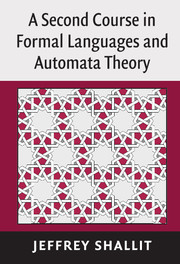1 - Review of formal languages and automata theory
Published online by Cambridge University Press: 05 June 2012
Summary
In this chapter we review material from a first course in the theory of computing. Much of this material should be familiar to you, but if not, you may want to read a more leisurely treatment contained in one of the texts suggested in the notes (Section 1.12).
Sets
A set is a collection of elements chosen from some domain. If S is a finite set, we use the notation ∣S∣ to denote the number of elements or cardinality of the set. The empty set is denoted by φ. By A ∪ B (respectively A ∩ B, A − B) we mean the union of the two sets A and B (respectively intersection and set difference). The notation Ā means the complement of the set A with respect to some assumed universal set U; that is, Ā = {x ∈ U : x ∉ A}. Finally, 2A denotes the power set, or set of all subsets, of A.
Some special sets that we talk about include ℕ = {0, 1, 2, 3, …}, the natural numbers, and ℤ = {…, −3, −2, −1, 0, 1, 2, 3, …}, the integers.
Symbols, strings, and languages
One of the fundamental mathematical objects we study in this book is the string. In the literature, a string is sometimes called a word or sentence. A string is made up of symbols (or letters).
- Type
- Chapter
- Information
- Publisher: Cambridge University PressPrint publication year: 2008



